Funfactsaboutgoldensnubnosedmonkeys Funny Facts About Golden Snub Nosed Monkeys


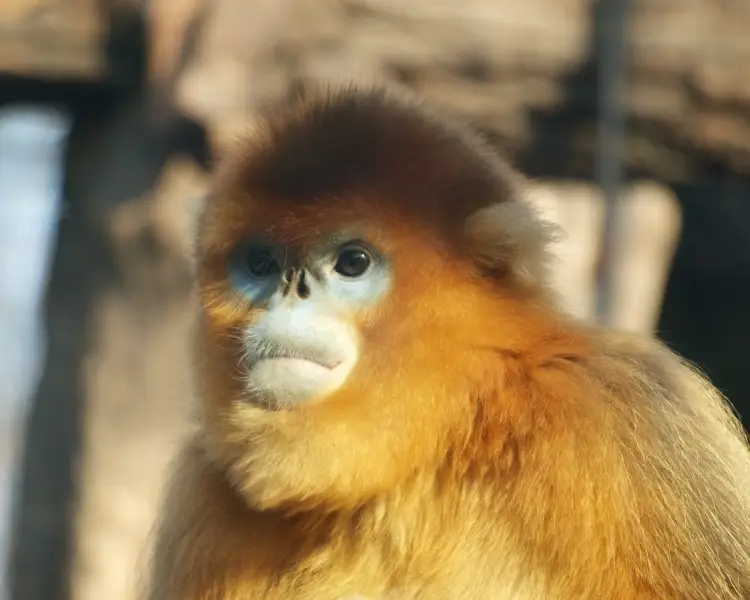
Golden Snub-Nosed Monkey
Sichuan golden snub-nosed monkey
This primate exhibits a rich golden brown to golden red fur with a black and golden patch on the back. The Golden snub-nosed monkey is endemic to China, where this animal inhabits coniferous montane forests with sharp temperature fluctuations (below freezing in winter and up to 25 °C (77 °F) in summer). The tail is as long as the body. The pale blue face resembles a trefoil. Additionally, mature males of this species exhibit red swellings at the corners of their mouth.
Photos with Golden Snub-Nosed Monkey
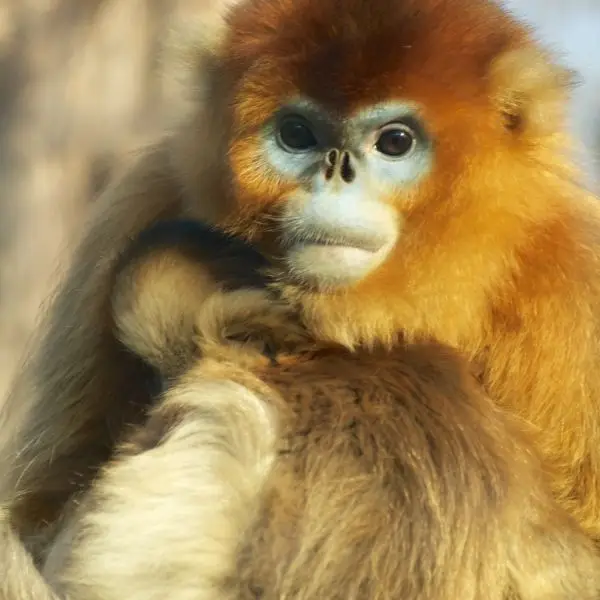
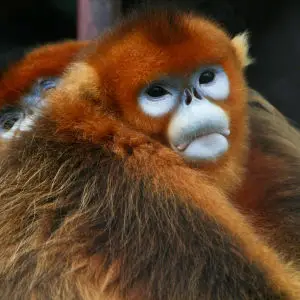
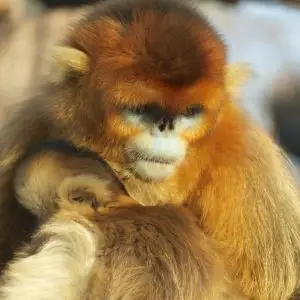
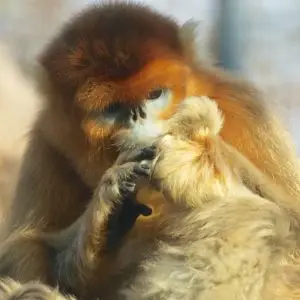
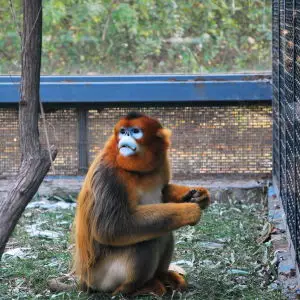
View 12 more photos of Golden Snub-Nosed Monkey
Video
Distribution
Geography
The natural range of Golden snub-nosed monkeys stretches throughout western-central China, namely, in the provinces of Sichuan, Gansu, Hubei and Shaanxi. Within this area, Golden snub-nosed monkeys are generally found in high mountainous, deciduous broadleaved and coniferous forests. During the winter months, they usually move to lower altitudes.
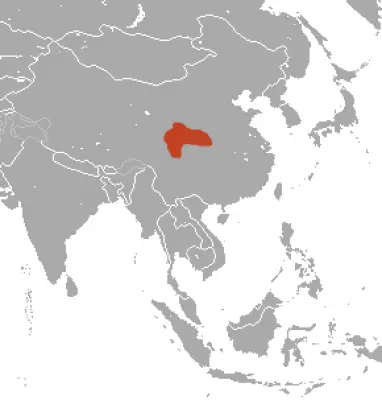
Biome
Climate zones
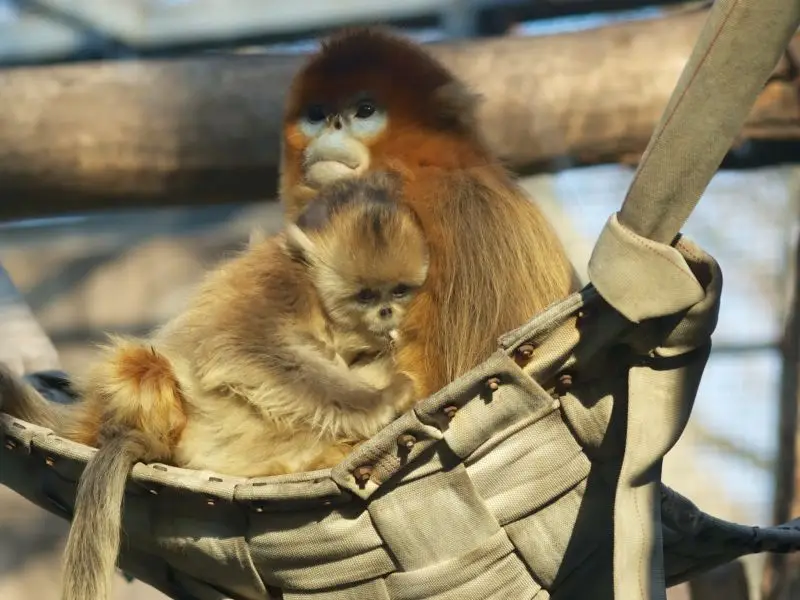
Habits and Lifestyle
These primates are highly social. During the summer months, the Golden snub-nosed monkeys gather into large groups of up to 200 individuals. During the winter, these animals typically live in smaller groups of 20 - 30 monkeys. They can occasionally be observed in huge concentrations of as many as 600 individuals, made up of several groups, which, in turn, are divided into smaller family units that consist of single dominant male and about 4 females with their offspring. These monkeys spend most of their active time in trees, although they are also known to feed on the ground. When threatened, they climb high up into the trees for shelter. The primary form of communication in this species is a rather unusual, ventriloquist type of vocalization, during which they move neither their body nor face. Most common calls include whines and shrills, usually used by males and females when feeding.
Diet and Nutrition
As herbivores, the Golden snub-nosed monkeys consume a wide range of food. Their diet generally consists of pine needles and young firs, being supplemented by bamboo shoots, leaves, buds and fruits.
Mating Habits
Year-round, peaks in September-November
Golden snub-nosed monkeys are polygynous, which means that one male gets an exclusive right to mating with multiple females. As a general rule, receptive females are the initiators of mating, announcing of their readiness through various signals and postures. They breed year-round with a peak period, occurring in September-November. Most births occur in March-May. Gestation period lasts for 7 months, yielding a single offspring. During the first few days after birth, the baby is nursed and carried in arms of its mother, constantly remaining with her until about 20 days old. Then the young monkey begins living with the group of its mother and is weaned at 1 year old. Males of this species are ready to mate at 7 years old, whereas females are mature by 4 - 5 years old.

Population
Population threats
The Golden snub-nosed monkeys currently suffer from large-scale hunting for food. The pelt of this animal has a commercial value, while some parts of its body are used in traditional medicine. Moreover, whole communities have been known to engage in round-ups of these animals. The Golden snub-nosed monkeys are also poached to be sold to zoos. And finally, these primates are threatened by loss of their natural range as a result of deforestation and habitat degradation.
Population number
According to the IUCN Red List, the total population of Golden snub-nosed monkeys is around 15,000 individuals, including estimates of the following subspecies' populations: Moupin golden snub-nosed monkeys - 10,000 individuals/ 100 groups in Sichun (namely, 6,000 in Mingshan Mountain, 3,500 in Qionglaishan Mountain and 500 - in Daxiangling and Xiaoxianling Mountain), 800 animals/ 8 groups in Gansu and finally, 170-200 monkeys/ 1 - 2 groups in Shaanxi; Quinling golden snub-nosed monkeys - about 3,800-4,000 individuals/ 39 troops; and Hubei golden snub-nosed Monkeys - around 600-1,000 animals/ 5-6 troops. Overall, the population of Golden snub-nosed monkeys is decreasing today, and the animals are classified as Endangered (EN) on the IUCN Red List.
Ecological niche
The Golden snub-nosed monkeys may affect plant growth through their herbivory.
Fun Facts for Kids
- The Golden snub-nosed monkeys belong to the group of Old World monkeys. The tails of these animals are covered with thick fur, acting as a cushion to sit on. However, their tails are useless for hanging from trees or grasping objects. Additionally, they exhibit human-like nostrils that are located close to each other.
- When sleeping, they huddle together in clusters. This manner of sleeping helps them conserve heat during cool nights. Females and their offspring usually huddle together, whereas males sleep separately.
- The origin of their unusual nose and facial features is presently unknown.
- The Golden snub-nosed monkeys are very vocal primates. Individuals of both sexes use vocalizations such as grunts, sighs, moans or belches. However, males and females may use different calls. For example, when grooming or feeding, males of this species are known to emit identifying whines - long hesitant cries, responded by female squeaks and squeals. Additionally, females can often be heard giving out chucks - "ee-tcha" calls, associated with stimulation.
- This species gets its scientific name after Roxellana, who was the consort of Süleyman the Magnificent, the Ottoman sultan. She was said to have reddish-gold hair and a snub nose.
References
More Fascinating Animals to Learn About
mcchristianantionce.blogspot.com
Source: https://animalia.bio/golden-snub-nosed-monkey
0 Response to "Funfactsaboutgoldensnubnosedmonkeys Funny Facts About Golden Snub Nosed Monkeys"
Post a Comment